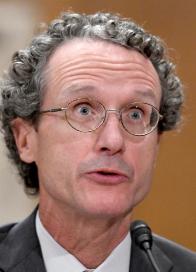E.P.A. Plans to Get Thousands of Pollution Deaths Off the Books by Changing Its Math




The Environmental Protection Agency plans to change the way it calculates the health risks of air pollution, a shift that would make it easier to roll back a key climate change rule because it would result in far fewer predicted deaths from pollution, according to five people with knowledge of the agency’s plans.
The E.P.A. had originally forecast that eliminating the Obama-era rule, the Clean Power Plan, and replacing it with a new measure would have resulted in an additional 1,400 premature deaths per year . The new analytical model would significantly reduce that number and would most likely be used by the Trump administration to defend further rollbacks of air pollution rules if it is formally adopted.
The proposed shift is the latest example of the Trump administration downgrading the estimates of environmental harm from pollution in regulations. In this case, the proposed methodology would assume there is little or no health benefit to making the air any cleaner than what the law requires. Many experts said that approach was not scientifically sound and that, in the real world, there are no safe levels of the fine particulate pollution associated with the burning of fossil fuels.
Fine particulate matter — the tiny, deadly particles that can penetrate deep into the lungs and enter the bloodstream — is linked to heart attacks, strokes and respiratory disease.
The five people familiar with the plan, all current or former E.P.A. officials, said the new modeling method would appear in the agency’s analysis of the final version of the replacement regulation, known as the Affordable Clean Energy rule, which is expected to be made public in June.

William L. Wehrum, the E.P.A.
assistant administrator for air and radiation.
Ron Sachs/CNP/MediaPunch
“It’s a very important issue, and it’s an issue where there has been a lot of debate over what the right approach is,” Mr. Wehrum said.
The E.P.A., when making major regulatory changes, is normally expected to demonstrate that society will see more benefits than costs from the change. Experts said that, while benefits would appear on paper in this case, the change actually disregards potential dangers to public health.
“Particulate matter is extremely harmful and it leads to a large number of premature deaths,” said Richard L. Revesz, an expert in environmental law at New York University. He called the expected change a “monumental departure” from the approach both Republican and Democratic E.P.A. leaders have used over the past several decades and predicted that it would lay the groundwork for weakening more environmental regulations.
“It could be an enormously significant impact,” Mr. Revesz said.
The Obama administration had sought to reduce planet-warming greenhouse gas emissions under the Clean Power Plan by pushing utilities to switch away from coal and instead use natural gas or renewable energy to generate electricity. The Obama plan would also have what is known as a co-benefit: levels of fine particulate matter would fall.
The Trump administration has moved to repeal the Obama-era plan and replace it with the Affordable Clean Energy rule, which would slightly improve the efficiency of coal plants. It would also allow older coal plants to remain in operation longer and result in an increase of particulate matter.
Particulate matter comes in various sizes. The greatest health risk comes from what is known as PM 2.5, the range of fine particles that are less than 2.5 microns in diameter. That is about one-thirtieth the width of a human hair.
The E.P.A. has set the safety threshold for PM 2.5 at a yearly average of 12 micrograms per cubic meter. While individual days vary, with some higher, an annual average at or below that level, known as the particulate matter standard, is considered safe. However, the agency still weighs health hazards that occur in the safe range when it analyzes new regulations.
Industry has long questioned that system. After all, fossil fuel advocates ask, why should the E.P.A. search for health dangers, and, ultimately, impose costs on industry, in situations where air is officially considered safe?
Mr. Wehrum, who worked as a lawyer and lobbyist for chemical manufacturers and fossil fuel businesses before moving to the E.P.A., echoed that position in two interviews. He noted that, in some regulations, the benefits of reduced particulate matter have been estimated to total in the range of $40 billion.
“How in the world can you get $30 or $40 billion of benefit to public health when most of that is attributable to reductions in areas that already meet a health-based standard,” he said. “That doesn’t make any sense.”
Mr. Wehrum acknowledged that the administration was considering a handful of analyses that would reduce the prediction of 1,400 premature deaths as a result of the measure.
He called the attention given to that initial forecast “unfortunate” and said the agency had included the figure in its analysis to show the varied results that can be achieved based on different assumptions.
Mr. Wehrum said the analyses the agency is conducting “illuminate the issue” of particulate matter and the question of what level is acceptable for the purposes of policymaking. He said new approaches would allow for public debate to move ahead and that any new methods would be subject to peer review if they became the agency’s primary tool for measuring health risks.
“This isn’t just something I’m cooking up here in my fifth-floor office in Washington,” Mr. Wehrum said.
Roger O. McClellan, who has served on E.P.A. advisory boards and as president of the Chemical Industry Institute of Toxicology, an industry-financed research center, said that the data for health risks below the particulate matter standard was weak and that he did not accept the argument that agencies must calculate risk “down to the first molecule of exposure.”
“These kinds of approaches — that every molecule, every ionization, carries with it an associated calculable health risk — are just misleading,” Mr. McClellan said.
To put the matter in perspective, most scientists say particulate matter standards are like speed limits. On many highways, a limit of 65 miles per hour is considered reasonable to protect public safety. But that doesn’t mean the risk of an accident disappears at 55 m.p.h., or even 25.
Jonathan M. Samet, a pulmonary disease specialist who is dean of the Colorado School of Public Health, said the most recent studies showed negative health effects well below the 12-microgram standard. “It’s not a hard stop where we can say ‘below that, air is safe.’ That would not be supported by the scientific evidence,” Dr. Samet said. “It would be very nice for public health if things worked that way, but they don’t seem to.”
Daniel S. Greenbaum, president of the Health Effects Institute, a nonprofit research organization that is funded by the E.P.A. and industry groups, acknowledged there was uncertainty around the effects of fine particulate matter exposure below the standard.
He said it was reasonable of the Trump administration to study the issue, but he questioned moving ahead with a new system before those studies are in. “To move away from the way this has been done without the benefit of this full scientific peer review is unfortunate,” he said.
Initial image: The Hunter power plant in Castle Dale, Utah, which burns an estimated 4.5 million tons of coal a year. Brandon Thibodeaux for The New York Times



So you're not talking about real deaths that occurred, but only "potential" ones that might, maybe, perhaps, happen.
Once again, the misleading title.
I don't agree. We deal with "theoretical" and "potential", all the time.
The title says that a change in math would take thousands of deaths off the books. I don't think that could possibly mean that the math would resuscitate dead people. "Potential/probable deaths" are the only kind that math can kill. (Hmmm... if we kill potential dead, do they become alive?)
So much for the Pro-Life President and his sycophants. We can change counts of potential deaths to real ones and increase the costs of health care for everyone else that survives. All so some rich people can get a tiny bit richer.